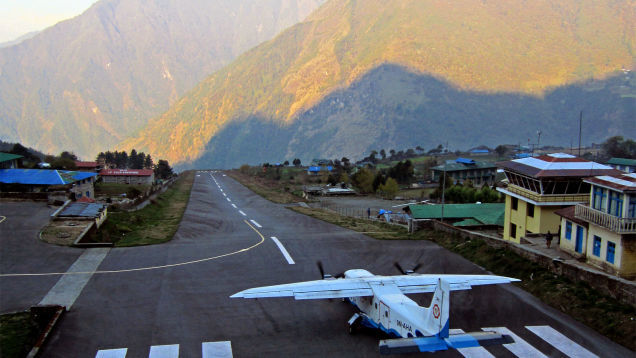Gravity helps at the tiny airport
 Lukla airport in Nepal is one of the strangest in the world. Built to support tourism to the Himalayas, the airport has a single landing runway. What is more, the runway is only 20 m wide, 450 m long, and a 2,800 m cliff at the runway's end, leaving little room for error. In fact, the airport can only be used by so-called Short Takeoff and Landing planes (STOL). Helping somewhat is a 12% incline in the runway from start to finish, so that planes rise through over the course of their deceleration.
Lukla airport in Nepal is one of the strangest in the world. Built to support tourism to the Himalayas, the airport has a single landing runway. What is more, the runway is only 20 m wide, 450 m long, and a 2,800 m cliff at the runway's end, leaving little room for error. In fact, the airport can only be used by so-called Short Takeoff and Landing planes (STOL). Helping somewhat is a 12% incline in the runway from start to finish, so that planes rise through over the course of their deceleration.
Suppose a STOL plane's landing speed is 45 m/s ( 100 mph). Neglecting any other effects like wind flaps, or drag, how small will the plane's velocity (in m/s) be at the top of the runway?
Details
- The runway itself is 450 m long, i.e. if you walked from the bottom to the top, you'd walk 450 m along the runway.
- An % incline means that if you walk a distance along an incline, your rise is given by .
The answer is 31.0728.
This section requires Javascript.
You are seeing this because something didn't load right. We suggest you, (a) try
refreshing the page, (b) enabling javascript if it is disabled on your browser and,
finally, (c)
loading the
non-javascript version of this page
. We're sorry about the hassle.
We can use the work-kinetic energy theorem .
W net = 2 1 m v f 2 − 2 1 m v i 2
Only gravity is doing work here, so W net = − m g Δ h . Hence,
− m g Δ h = 2 1 m v f 2 − 2 1 m v i 2
− g Δ h = 2 1 v f 2 − 2 1 v i 2
v f = v i 2 − 2 g Δ h
Now we put in the values:
g = 9 . 8 m s − 2 , Δ h = 4 5 0 × sin θ = 4 5 0 × 0 . 1 2 m
v i = 4 5 m s − 1 .
After substituting these values, we get
v i ≈ 3 1 . 0 7 m s − 1 □